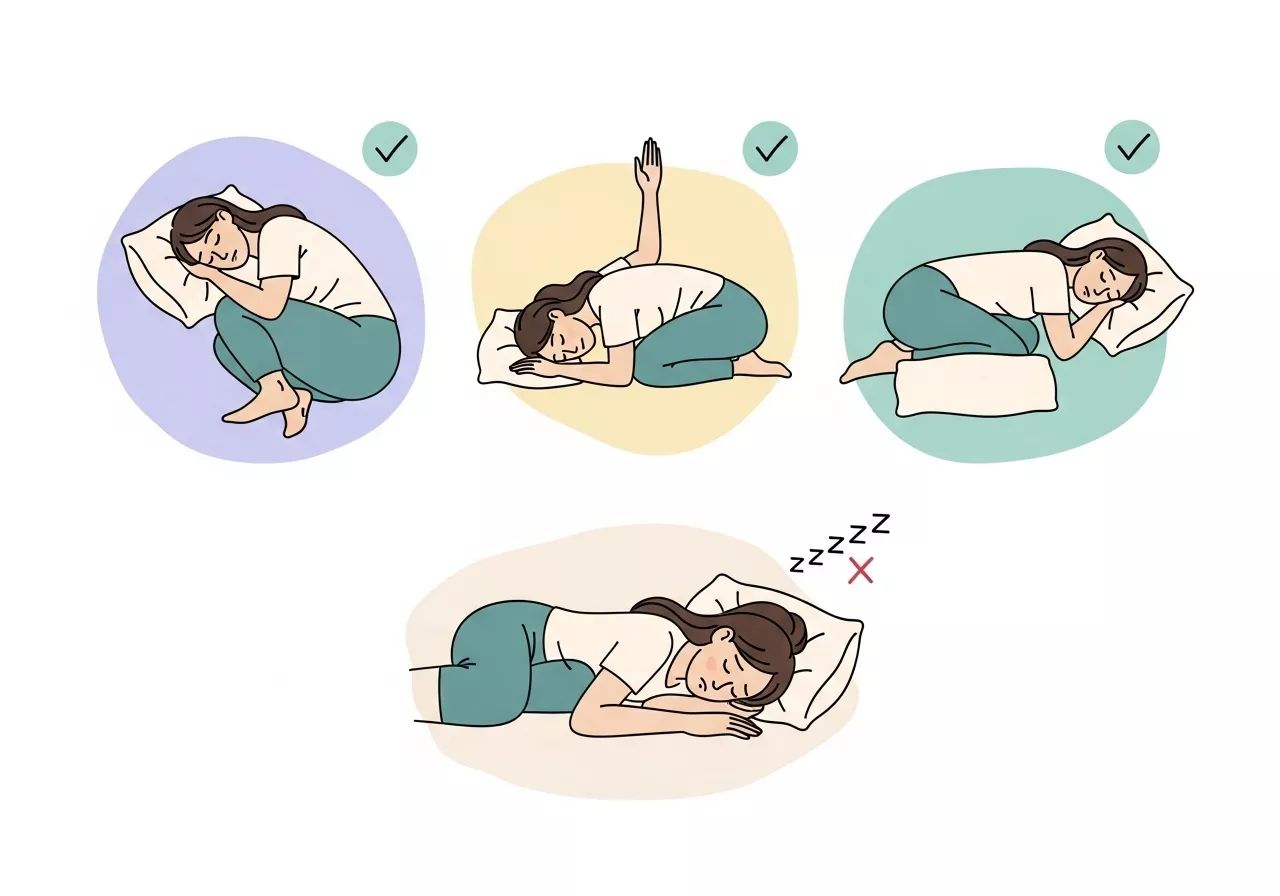Eagle Pose, or Garudasana, is a standing balance pose in yoga that involves wrapping one arm under the other and intertwining them, creating a deep stretch in the shoulders and upper back.

However, many practitioners find the arm position challenging due to tightness in the shoulders or limited flexibility.
Fortunately, there are several modifications and preparatory practices that can help you work towards the full expression of Eagle Arms.
Understanding the Challenge
Difficulty in achieving Eagle Arms often stems from tight shoulders, limited upper back mobility, or anatomical variations.
These factors can make it hard to fully wrap the arms and press the palms together.
It’s important to approach this pose with patience and to honor your body’s current capabilities.
Modifications for Eagle Arms

- Self-Hug: Instead of intertwining the arms, cross them over your chest and place each hand on the opposite shoulder, giving yourself a hug. This alternative provides a similar stretch across the upper back and shoulders.
- Use of a Strap: Hold a yoga strap or towel between your hands. Extend your arms forward, cross one arm under the other, and grasp the strap with both hands. This method allows you to experience the stretch without forcing the palms together, gradually increasing shoulder flexibility.
- Grasp Opposite Shoulders: Cross your arms in front of you and place your hands on the opposite shoulders, as if giving yourself a hug. This position stretches the upper back and shoulders without requiring the full arm wrap.
- Forearm Press: Cross your arms so that the backs of your hands face each other, and press the backs of your hands together. This modification provides a gentle stretch and can be a step towards the full expression of the pose.
Preparatory Poses to Increase Flexibility

- Cow Face Arms (Gomukhasana Arms): This pose stretches the shoulders and prepares them for deeper binds. Reach one arm overhead and the other behind your back, attempting to clasp the fingers. Use a strap if needed.
- Thread the Needle (Parsva Balasana): From a tabletop position, slide one arm under the other, bringing the shoulder and ear to the mat. This twist opens the shoulders and upper back.
- Shoulder Rolls and Stretches: Gentle shoulder rolls and stretches can help warm up the muscles and increase mobility, making it easier to attempt Eagle Arms.
Tips for Practice
- Warm-Up: Always begin with a proper warm-up to prepare the shoulders and upper back for deeper stretches.
- Use Props: Incorporate props like straps or towels to assist in achieving the desired stretch without strain.
- Be Patient: Flexibility improves over time with consistent practice. Avoid forcing your body into positions that cause pain or discomfort.
- Seek Guidance: Working with a qualified yoga instructor can provide personalized modifications and ensure proper alignment.
Remember, yoga is a personal journey, and it’s essential to honor your body’s unique capabilities.
By incorporating these modifications and preparatory practices, you can gradually work towards achieving Eagle Arms in a safe and effective manner.
What Makes Eagle Arms So Difficult?
Eagle Arms, the upper body component of Garudasana (Eagle Pose), is a challenging position for many practitioners.
The pose involves wrapping one arm under the other, crossing at the elbows, and bringing the palms together.

While it may look simple, achieving this position requires significant flexibility, strength, and coordination. Let’s explore the reasons behind its difficulty in detail.
1. Limited Shoulder Mobility
Why It Happens:
- Tight shoulders are one of the most common reasons people struggle with Eagle Arms. This tightness often results from prolonged sitting, poor posture, or repetitive movements that limit the range of motion.
- Over time, the muscles and connective tissues in the shoulders become stiff, making it challenging to achieve the deep rotation needed for Eagle Arms.
Impact on the Pose:
- Without adequate mobility, practitioners may find it difficult to cross the arms deeply enough to bring the palms together.
2. Upper Back Tension
Why It Happens:
- Stress, poor posture, and lack of movement can cause tightness in the upper back. This area plays a critical role in the flexibility needed to draw the shoulder blades apart and achieve the arm wrap.
- Sedentary lifestyles, such as sitting at a desk for extended periods, exacerbate upper back tension.
Impact on the Pose:
- Tension in the upper back restricts the ability to expand and stretch through the shoulder girdle, making the arm crossing uncomfortable or impossible.
3. Lack of Arm Strength and Stability
Why It Happens:
- Eagle Arms require a certain level of strength to hold the arms in position while maintaining balance. Weakness in the shoulders, arms, or upper back can make it difficult to sustain the pose.
- For beginners, this challenge is compounded by the unfamiliar coordination required for the arm wrap.
Impact on the Pose:
- Without adequate strength, practitioners may struggle to lift the elbows or press the palms together, leading to a less effective stretch.
4. Anatomical Variations
Why It Happens:
- Every body is different, and some people have structural limitations that make Eagle Arms more challenging. Factors like shorter arms, larger muscle mass, or specific joint configurations can affect the ability to fully wrap the arms.
Impact on the Pose:
- Anatomical variations may require practitioners to modify the pose or use props to achieve a similar stretch.
5. Coordination and Proprioception Challenges
Why It Happens:
- Eagle Arms involve a level of coordination that can be tricky, especially for beginners. The motion of wrapping one arm under the other and aligning the hands and elbows in the right position can feel unfamiliar.
- Proprioception (awareness of your body’s position in space) plays a significant role, and it may take time to develop this skill.
Impact on the Pose:
- Difficulty in coordinating the movement can lead to frustration and improper alignment.
6. Mental and Emotional Tension
Why It Happens:
- Stress and emotional tension often manifest physically, particularly in the shoulders and upper back. This can make Eagle Arms feel more restrictive or uncomfortable.
- The mental challenge of attempting a pose that feels difficult can also lead to a lack of confidence or a tendency to give up too quickly.
Impact on the Pose:
- Emotional tension adds to physical tightness, making it harder to achieve the desired stretch and alignment.
7. Inadequate Warm-Up
Why It Happens:
- Jumping into Eagle Arms without properly warming up the shoulders and upper back can limit flexibility and increase the risk of strain.
- Key areas, such as the rotator cuffs, deltoids, and upper trapezius, need activation and gentle stretching to prepare for the pose.
Impact on the Pose:
- Without a warm-up, the shoulders and back are less pliable, making the arm wrap feel stiff and uncomfortable.
Tips to Overcome the Challenges of Eagle Arms
1. Warm Up Thoroughly:
- Incorporate poses like Cat-Cow, Shoulder Rolls, and Thread the Needle to prepare the shoulders and upper back.
2. Use Props:
- A yoga strap can help bridge the gap between your hands if you can’t fully wrap your arms.
3. Modify the Pose:
- Try self-hugging (placing each hand on the opposite shoulder) or pressing the backs of your hands together instead of the palms.
4. Focus on Breathwork:
- Deep breathing can help release tension and increase relaxation, making it easier to achieve the pose.
5. Be Patient and Consistent:
- Flexibility and strength take time to develop. Practice regularly and celebrate small progress.
Conclusion
Eagle Arms is challenging because it requires a combination of flexibility, strength, coordination, and patience.
Tight shoulders, upper back tension, and anatomical differences are common obstacles, but these can be addressed with modifications, props, and preparatory exercises.
By approaching the pose mindfully and respecting your body’s limits, you can gradually work toward mastering Eagle Arms and enjoying its numerous benefits.
Remember, yoga is about progress, not perfection!



